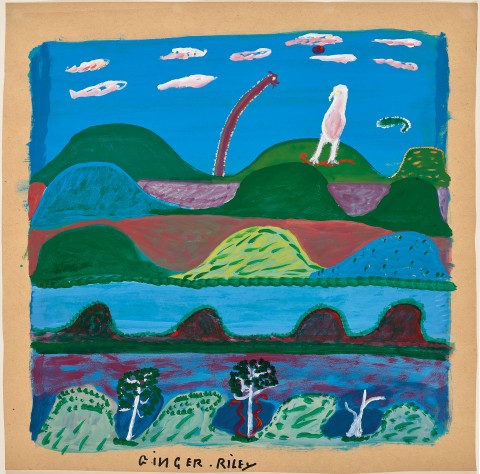SIX WORKS, 1993
GINGER RILEY MUNDUWALAWALA
I. CREATION – FOUR ARCHERS WITH NGAK NGAK, GARIMALA AND ANT HILLS, 1993
II. WAWALU AT THE FOUR ARCHERS WITH SACRED SHARK LIVER TREE, 1993
III. NGAK NGAK ACTING AS SENTINEL IN LIMMEN BIGHT COUNTRY, 1993
IV. ANGRY BULUKBUN IN LIMMEN BIGHT COUNTRY, 1993
V. WAWALU WITH ANCESTORS AT THE FOUR ARCHERS, 1993
VI. LIMMEN BIGHT COUNTRY BEFORE THE WET, 1993
synthetic polymer paint on craft paper
56.0 x 56.0 cm (each)
each signed lower centre: GINGER . RILEY
each inscribed with titles on typed labels verso
Painted in the Ngukurr region of South–East Arnhem land in 1993
Alcaston Gallery, Melbourne
The Laverty Collection, Sydney, acquired from the above in September 1993
A century of collecting, 1901 – 2001: celebrating the Centenary of Federation by showcasing works from private collections, Ivan Dougherty Gallery, University of New South Wales, College of Fine Arts, Sydney, 29 March – 28 April 2001 (IV)
Heart and Soul: the Laverty Collection, Sydney, AAMU, Utrecht, The Netherlands, 20 January – 10 June 2012 (I, II, III, IV, V, VI)
Laverty, C., Diversity and Strength: Contemporary Australian Aboriginal Art – A Private Collection, Arts of Asia, Hong Kong, November – December 2013, cat. 31 (illus. front cover and p. 93 (VI))
Beyond Sacred: Australian Aboriginal Art: The Collection of Colin and Elizabeth Laverty, edition II, Kleimeyer Industries Pty Ltd, Melbourne, 2011, pp. 358 – 361 (illus.), 390
Expressieve kracht, Kunst & Cultuur magazine, Netherlands, no. 1, March 2012, p. 24 (illus.) (III)
Pulsating with energy and enlivened by Riley’s daring use of colour, the suite of six paintings offered here encapsulate a sequence of events inspired by the artist’s mother country – the coastal saltwater area in south-east Arnhem Land which extends from the Gulf of Carpentaria along the Limmen Bight River to the Four Archers, approximately 50 kilometres inland. Punctuating the works are many signature motifs from Riley’s repertoire, including the mythological serpent Garimala (here depicted as two snakes to denote him travelling, or alternatively as a rainbow associated with water and the life cycle); the totemic white-breasted sea eagle, Ngak Ngak, who fulfils the role of a sentinel or guardian protecting the country; the heavy, rain-filled clouds which herald the fertile abundance of the wet season, while also symbolising the artist’s mother; and the shark liver tree which is not a natural tree but a ceremonial totemic construction pertaining to his mother’s creation story. Indeed, according to the ancestral dreaming, Garimala journeyed from afar down the Limmen Bight River to create the geographical formation known as the Four Archers – an area to which Riley refers as ‘the centre of the earth, where all things start and finish’1 and where the serpent lives nearby. The story continues that Garimala ‘travelled from the Four Archers to Nyamiyukanji in the Limmen Bight River, disappeared under the water and metamorphosed into the Rainbow Serpent’2, associated with the life-giving properties of fresh water, the monsoon season and the continuing cycle of life; while in another manifestation, this snake hero becomes Bulukbun, an aggressive, fire-breathing serpent dragon who rises out of the sea and kills people.
Although much of Riley’s oeuvre is distinguished by the endurance of this singular narrative, his iconography is not restrictive, nor does it betray a lack of innovation. To the contrary, the repetition of his mother’s stories allows for greater depth of exploration and revelation; as Riley himself reflects, such paintings are ‘…the same, but different.’3 Same referring to the consistently employed subject matter, story and country, but different in each work’s unique conception, paint and design.
1. Riley cited in Ryan, J., Ginger Riley, National Gallery of Victoria, Melbourne, 1997, p.15
2. Riley, ibid., p.30
3. Riley, ibid., p.10
VERONICA ANGELATOS






